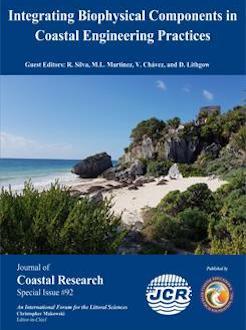Miret-Villaseñor, D.; Enriquez, C.; Mariño-Tapia, I.; Silva, R., and Ruiz, G., 2019. Interactions between nearshore and shelf dynamics under hurricane conditions: Implications for exposed and reef protected beaches. In: Silva, R.; Martínez, M.L.; Chavez, V., and Lithgow, D. (eds.), Integrating Biophysical Components in Coastal Engineering Practices. Journal of Coastal Research, Special Issue No. 92, pp. 55–67. Coconut Creek (Florida), ISSN 0749-0208.
The Caribbean Sea has 2.5 hurricanes per year on average, some of which have caused major damage to beaches in the past 3 decades. Wilma was a major hurricane that hit the Mexican Caribbean in 2005, generating strong erosion at Cancun, an exposed beach, and accretion at Puerto Morelos, a reef-protected beach located 28 km to the south. The present work analyses this contrasting response by studying the hydrodynamic processes at these two beaches, and the interaction between surf-zone and shelf-scale currents. The coupled wave-flow Delft3D model is used to generate the hydrodynamic conditions at three contrasting scales: basin, regional and nearshore; the latter being high resolution 3D models. Results show a wide surf zone with well-developed offshore directed currents (undertows) at the exposed beach, which intersect an intense southward wind driven current at the shelf. At the reef-protected beach, breaking waves generate strong cross-reef currents into the reef lagoon, where seas are much calmer. These combinations of processes can promote the export of sand from the exposed beach, transport southward and entry onto the reef protected coast. Numerical experiments are carried out to study further the effects of a variation in hurricane track and forward speed on the synchronicity of the processes. Results show that minor differences in trajectory and forward speed can produce very different outcomes. Slight changes in the trajectory to the north or south (~ 75 km), for a hurricane with the same characteristics as Wilma, generate alongshore currents close to the beach, which would limit the offshore and southward sand transport. Hurricane forward speed plays a role in the persistence of processes and the resulting hydrodynamics, which would have important morphological implications.





